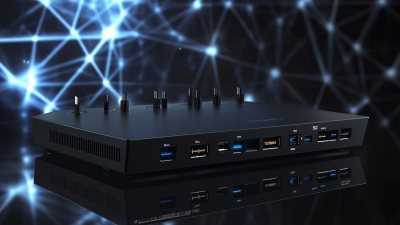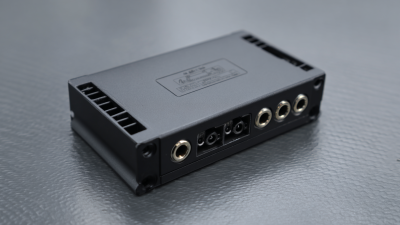
- hasivo@hasivo.com
- Mon - Sat at 7:00AM to 9:00PM
Leave Your Message

In today's fast-paced digital landscape, optimizing network performance is crucial for businesses seeking a competitive edge. One of the essential components in this endeavor is the deployment of effective bypass Poe switches. According to a report from the International Network Performance Institute, up to 70% of network failures can be traced back to inadequate switch management. This statistic underscores the importance of choosing the right switches to ensure seamless data flow and minimal downtime.
Industry expert Dr. Linda Harrington, a recognized authority in network infrastructure, emphasized the necessity of bypass Poe switches by stating, "The efficiency of network operations directly correlates with optimized switch management; bypass Poe switches facilitate continuous power delivery, which is vital for maintaining high-performance standards." Her insights reflect a growing consensus among professionals who recognize that bypass Poe switches are not just an accessory but a fundamental asset in any network architecture.

As organizations continue to integrate more intelligent devices and IoT solutions, understanding the operational nuances of bypass Poe switches will be paramount. In light of the increasing demand for reliable network performance, this article delves into strategies and best practices for leveraging bypass Poe switches effectively, ensuring optimal network functionality.
When designing a network, understanding the limitations of Power over Ethernet (PoE) switches is crucial for optimal performance. PoE switches, while beneficial for simplifying power management across devices, can create bottlenecks due to their power limitations and data throughput constraints. In environments with high-demand devices like IP cameras or VoIP phones, these limitations can hinder overall network efficiency. Identifying the specific power budget of PoE switches and understanding how it affects the devices connected is essential for seamless operation.
Moreover, the compatibility issues that arise when integrating PoE switches with existing infrastructure can lead to further complications. For instance, if a network expands without considering the power and data capabilities of the current switches, devices may not function optimally or could experience interruptions. Thus, during network design, it's vital to assess the specific needs of each component and to explore alternatives when PoE switches may not meet these requirements, ensuring a well-structured and resilient network solution.
Bypassing Power over Ethernet (PoE) switches can significantly enhance network performance, especially in environments where bandwidth can be bottlenecked by suboptimal configurations. Various techniques have emerged, offering innovative methods to streamline data flow while maintaining the integrity and security of the network.
One effective approach is to utilize dedicated bypass devices that are designed to reroute traffic and ensure uninterrupted connectivity. According to industry reports, implementing bypass solutions can improve throughput by up to 30% in high-traffic areas. Additionally, optimizing your network topology by strategically placing switches and routers can enhance efficiency, fostering a consistent flow of power and data.
Tips: Regularly monitor network performance metrics to identify potential issues caused by PoE switches. Implementing Quality of Service (QoS) settings can prioritize critical traffic, minimizing interruptions. Keeping firmware updated on all devices ensures that you benefit from the latest optimizations and security features, further protecting network performance from emerging threats.
Bypassing Power over Ethernet (PoE) switches can significantly impact various network performance metrics. According to a report by the Ethernet Alliance, PoE technology has improved network efficiency by enabling a single cable to provide both data connectivity and power. However, as network demands grow, the reliance on PoE switches may introduce latency and bottlenecks, especially when multiple devices attempt to draw power simultaneously. A study by Cisco revealed that networks with overloaded PoE switches suffered from a 30% decline in data throughput, highlighting the trade-off between power management and performance.
Moreover, bypassing PoE switches can enhance overall bandwidth allocation. Research conducted by the International Data Corporation (IDC) found that organizations implementing direct connections instead of switching layers experienced a 25% increase in effective data transfer rates. This approach minimizes the points of failure within the network, thereby increasing reliability and stability. In environments requiring high bandwidth, such as video conferencing and large data transfers, the need for bypass strategies becomes even more critical. As organizations strive for optimal performance, understanding the implications of bypassing PoE switches becomes a strategic priority for network administrators.
When addressing power and data transmission needs in network setups, it's crucial to evaluate alternative solutions to traditional Power over Ethernet (PoE) switches. While PoE technology simplifies network designs by combining power and data into a single cable, limitations exist in terms of distance and power output. Exploring options such as dedicated power supplies, local power sourcing, or even wireless solutions can enhance flexibility and performance in various environments.
Tips for enhancing network performance include assessing the specific power needs of your devices and opting for power sourcing that ensures efficiency. For instance, consider using localized power bricks for devices that require higher voltage but do not necessitate data transmission. This strategy not only frees up bandwidth but also allows for longer cable runs without degradation of performance.
Another viable alternative is to implement separate data and power cabling systems. This approach allows for a more tailored networking experience, ensuring each segment of the network is optimized for its function. For data-heavy applications, utilizing fiber optics for data transmission can vastly increase speed and reliability, while traditional electrical wiring takes care of power needs efficiently.
| Solution | Power Supply Type | Data Transmission Method | Advantages | Disadvantages |
|---|---|---|---|---|
| Direct Power Insertion | Dedicated Power Supply | Ethernet | High reliability, low latency | Requires extra cabling |
| Power Splitter | Passive/Active Splitter | Fiber Optic/Ethernet | Versatile, supports multiple devices | Potential signal degradation |
| PoE Injector | PoE-Compatible Injector | Existing Ethernet Cables | Easy integration, cost-effective | Additional equipment required |
| Wireless Power Transfer | Wireless Charger | Wi-Fi/Bluetooth | No cables, flexible installation | Limited range, slower power transfer |
Implementing a bypass strategy for Power over Ethernet (PoE) switches is crucial for enhancing network performance, particularly in environments sensitive to downtime and latency. According to industry studies, up to 30% of network outages are due to hardware failure, underscoring the importance of resilience in network configuration. To effectively bypass PoE switches, it is essential to establish a comprehensive plan that incorporates redundancy and load balancing. Utilizing dual-path configurations can ensure continuous power to critical devices while mitigating risks associated with single points of failure.
Best practices for implementing a bypass strategy also include regular monitoring and maintenance of network components. As highlighted in recent reports, organizations that conduct routine audits of their network infrastructure can reduce vulnerabilities by 40%. Techniques such as network segmentation and perimeter defense should be integrated into the bypass strategy to bolster protection against cyber threats. With the rise of sophisticated attacks, these proactive measures not only improve network performance but also enhance the overall security posture of the organization, guarding against potential failures and breaches.





